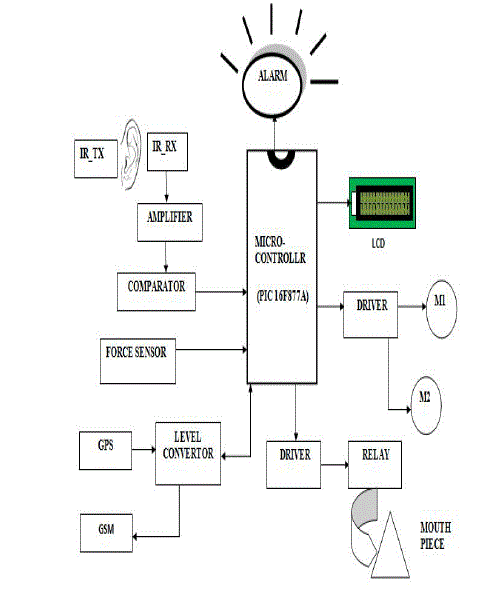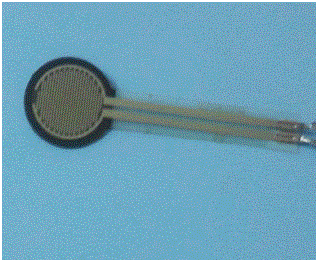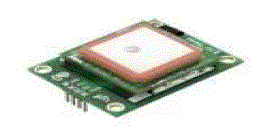| Cardiopulmonary resuscitation, Global Positioning System, Global System for Mobile communication, Self assisting CPR device. |
INTRODUCTION
|
| Sudden Cardiac Arrest is an important public health problem accounting for more than 4 Lakhs of death every year. More than half of these deaths occur before 65 years of age which explain the need for Cardio Pulmonary Resuscitation in order to improve patient’s chances of survival. CPR also known as “basic life support” is a technique that combines oral resuscitation which supplies oxygen to the lungs with external cardiac massage (chest compression). This consists of an initial assessment of the patient and a subsequent number of steps that includes airway maintenance and chest compression of the patient with cardiac arrest. The main causes of cardiac arrest are myocardial infarction, pulmonary embolism, ventricular fibrillation triggered due to acute ischemic events. |
RELATED WORK
|
| When heart stops beating during cardiac arrest the blood circulation sufficient to maintain the life can be provided by continuously compressing the heart through a physical force being applied to the patient chest. In [1] authors suggested that CPR protects the patient from death in association with myocardial and brain damage. The factors primarily responsible for successful recovery are: Lag in starting the treatment, the potency of a rescuers technique, Avoids internal deterioration to the heart and vital organs. |
| Automated device came into existence to overcome the drawbacks of manual CPR techniques, discussed by various authors are: The oxygenated blood flow to the brain and the heart may be even more reduced, if the manual chest compression is inadequate [2]. The Efficiency of video-based self instruction has been verified in several studies, however this method is not suitable with older adults. They require special training and knowledge in [3]. The use of hormones like vasopressin, epinephrine, has been studied in [4] for rescuing cardiac patients. These hormones may produce side effects in some patients after their recovery from cardiac arrest. Automated device requires a bystanders help in providing the compression to the patients. Automated device also provides greater control of compression preventing rib fractures and damage to vital organs [5]. In [6] authors described that automated chest compression device provides greater blood flow to vital organs and thereby improves the resuscitation outcome compared with the manual chest compression. |
| In[7] authors explained, automatic CPR can be properly administered by monitoring its compression force, the rate of compression and the blood flow rate so that the rescuer can assure that he is doing correctly. Half of the victims out of hospital with cardiac arrest failed to receive bystander initiated CPR. So, self assisting CPR device may play increasingly an important role in the future in raising the return of spontaneous circulation rate(ROSC),survival rate, the rate of survival to discharge and in avoiding the major complications to brain and heart. |
PROPOSED ALGORITHM
|
| A self rescuing Cardio Pulmonary Resuscitation (CPR) system is a portable chest compression device with mouthpiece for providing ventilation. This device is combined with the microcontroller and motor which is attached to the patient by means of a chest belt. Earlobe sensor with infrared (IR) transmitter and receiver worn by the patient monitors the heart beat of the patient continuously. If any abnormalities are being sensed, it takes the average blood flow rate and sends the information to the microcontroller. The microcontroller is programmed to provide adequate compression during cardiac arrest. If any sudden cardiac arrest occurs the patient retains his conscious stage for about 3-5 minutes and within the stipulated time required compression along with ventilation is provided for the patient. The heart beat range is displayed in a LCD and it also gives a warning alarm signal so that the patient can provide ventilation himself and it also will take the attention of nearby persons |
| The compression rate is set for providing 125mm Hg of pressure when the heart stops beating and a compression rate of 80 – 100mm Hg when the heart beats at 20 - 40 beats per minute (bpm) respectively. The compression stops for 5 seconds in order to allow ventilation to the patient. The self ventilation can be provided with the help of mouthpiece attached with an autoclave. |
| The microcontroller checks the status of the patient for few minutes and if the person is not recovering, an additional technology Global Positioning System (GPS) is used to identify the location of the patient and Global System for Mobile communication (GSM) to send the coded message to the programmed number, is attached with this device to provide immediate treatment and thereby immediate recovery of patient can be made possible. Figure 2.1 denotes the block diagram of CPR. |
A. EARLOBE SENSOR
|
| The ear lobe sensor with IR transmitter and receiver connected on either side of the ear is used as the heart beat sensor to acquire heart beat of the patient. It detects the heart beat of the patient continuously by passing the IR rays through the blood within the nerve cells. The back reflected IR signal is received by the IR receiver and it is fed to the amplifier. The amplified heart beat signal is given to the comparator for normal value comparison |
B. MICROCONTROLLER
|
| The microcontroller is the heart of the device. Microcontroller is the device controlling all the operation of the device. PIC16F877A used is an 8-bit Microcontroller System with Reduced Instruction Set of Computers (RISC) Architecture. It has small set of instruction set of 35-Instructions with Operating Speed Max 20 MHz, Voltage (2-5.5) V. It consumes low power and also has high speed Flash/EPROM Technology. The microcontroller receives the heart beat signal and it provides the force and ventilation as required by the person. |
C. FORCE SENSOR
|
| The force sensor is the device that measures the force given to the chest compression. A force sensor usually acts as a transducer it generates a signal as a function of the imposed force. It provides a linear output voltage that is proportional to the applied pressure. The force sensor used in this device is of resistive type and it is a compact one. This type of device is mainly used in case of medical instrumentation and robotics. Figure 2.2 denotes the force sensor. |
D. GLOBAL POSITIONING SYSTEM (GPS)
|
| GPS is a space based satellite navigation system. It provides the location and time information in all type of weather conditions anywhere on the earth. GPS system provides critical support to military and commercial users around the world. Using this system we can provide the location and time information of the patient to the programmed number easily. Figure 2.3 shows the GPS module. |
E. GLOBAL SYSTEM FOR MOBILE COMMUNICATION (GSM)
|
| European Telecommunications Standard Institute microcontroller (ETSI) developed the standards for GSM. It describes second generation protocols for digital cellular networks used by the mobile phones. Using this technology the coded message can be sent to the programmed number within few seconds. Figure 2.4 shows the GSM module. |
F. LEVEL CONVERTER
|
| MAX 232 is the level converter used to convert the RS232 levels to the Transistor -Transistor Logic (TTL). MAX 232 is an integrated circuit normally converts the receiver, transmitter, CTS and RTS signals. MAX232A is backwards compatible and operates at higher band width and can use smaller external capacitors .The microcontroller can accept only these converted levels from the GPS or GSM. It is a 16 pin device with a 5V supply. |
G. DRIVER
|
| The driver circuit controls another circuit such as high power transistor and regulates the current flowing through the circuit. The driver circuit is ULN2803 with a high voltage supply. It uses the low level signals mainly the TTL to switch on or turnoff the higher voltage. It is a18 - pin device with 8 input signals. |
H. MOTOR
|
| The motor used here is DC geared Motor. DC motors are part of the electric motors. In general, DC motors act same as that of the electric motors. 10RPM 12V DC motor is used for this device. This type of DC motor is mainly used for robotic applications. It is very easy to use and available in standard size of about 125gm weight. |
I. RELAY
|
| Relay is an electrically regulated switch. Current running through the coil will create a magnetic field that will alter the switch contact. It also allows one circuit to switch to another circuit. Relay switch helps in operating the ventilating device. |
RESULTS AND DISCUSSIONS
|
| The self assisting CPR device designed using earlobe sensor attached to the patient detects the heart beat of the patient continuously. The accuracy of ear lobe sensors was tested by connecting it to a normal person and it was observed with high rate of accuracy. |
| As there is no legal authority to test this CPR device for the abnormal patients it was tested with a prototype human model. The abnormal status of the patient has been reset in this model and it was operated with the help of a switch. When the switch is turn on, the microcontroller gets that information and it provides the required force to the patient for compression. The device designed is proved to be a simple self assisting and portable device. Figure 3.1 demonstrates the prototype model linked with a self assisting CPR and figure 3.2 denotes the prototype model linked with its hardware components. |
CONCLUSION
|
| An automatic simple and portable self assisting device CPR device is designed to comfort the cardiac patients on all counts. This self assisting device perfectly eradicates all the errors of manual CPR and bystander initiated CPR. |
| This device is an effective and safe mechanical device for handling out-of-hospital cardiac arrest patients. Self rescuing CPR devices may play an increasingly important role in furnishing consistent chest compression based the patient status along with ventilation. The LCD displays heart beat rate, warning alarm signal, GPS and GSM technology interfaced with this device are the added features of this work. GPS and GSM are used in locating the patient and inform the care taker immediately by sending a message to the registered number. |
| Further extension includes designing a self assisting CPR device by means of a single integrating system. This latter approach would lend itself to a more portable emergency use. |
ACKNOWLEDGMENT
|
| The authors wish to thank Dr.Antony Jenifer, Chettinad Hospital, Chennai and Dr.K. Bommana Raja,M.Tech.,Ph.D., Professor and Head of the Department, Department of Biomedical Engineering, PSNACET, Dindigul for rendering his valuable support for completing the work successfully. |
Figures at a glance
|
 |
 |
 |
| Figure 2.1 |
Figure 2.2 |
Figure 2.3 |
|
| |
 |
 |
 |
| Figure 2.4 |
Figure 3.1 |
Figure 3.2 |
|
References
|
- J.Herlitz, L.Ekstrom, B.Wennerblom, A Axelsson, A.Bang, “Effect Of Bystander Initiated CPR On Ventricular Fibrillation & SurvivalAfter Witnessed Cardiac Arrest Outside Hospital”, Br Heart , vol.72, pp.408-412, 1994.
- Henning Krepb, Mathias Mamiera, Martin Breil a, Ulrich Heistera, Matthias Fischerc, Andreas Hoefta, “ Out Of Hospital Cpr With Autopulse System - A Prospective Observational Study With A New Load-Distributing Band Chest Compression Device”, Elsevier, vol. 73, pp 86-95, 31 August 2007.
- Bonnie Lynch, Eric L Einspruch, Grham Nichol, LanceB.Becker, Tom P Aufderheid, “Effectiveness Of A 30- Min Cpr Self – Instruction Program For Lay Responders: A Controlled Randomized Study” Elsevier, vol.67 , pp.31-43, October 2005.
- Volker Wenzel, Anette C. Krismer, H. Richard Arntz,Helmut Sitter, Karl H. Stadlbauer and Karl H Lindner “A Comparison Of Vasopressin And Epinephrine For Out – Of – Hospital Cardiopulmonary Resuscitation”, vol. 350, pp.105-113, January 2004.
- Elroy T, Cantrell, Jon Spijkeman, “Chest Mounted Cardio Pulmonary Resuscitation Device And System” US Patent US6676613 B2, january 13, 2004 .
- Al Hallstrom, Thomas D. Rea, Michael.R, Sayre, Michele olsutka, “Manual Chest Compression Vs Use Of An Automated Chest Compression Device During Resuscitation Following Out Of Hospital Cardiac Arrest”, JAMA, vol.295(22), pp.2620-2628, June 2006.
- Kenneth B.kelly, Belle mead, N.J “Apparatus For Assisting In The Application Of Cardiopulmonary Resuscitation”, US Patent [19] ,March 5 1996.
- David G. Benditt, MaryAnn Goldstein, Richard Sutton, Demetris Yannopoulos “Dispatcher- Directed Bystander Initiated Cardio Pulmonary Resuscitation”, Journal Of Americian Heart Assosiation, vol.121, pp.10-13, 2011.
- Alfred Hallstrom, Leonard cobbb, Elise Johnson, and Michael copass, “Cardiopulmonary Resuscitation By Chest Compression Alone Or With Mouth – To – Mouth Ventilation” vol.342, pp.1546-1543, 2003.
- Xin Li, Qing-ling Fu, Xiao-li Jing, Yu-jie Li, Hong Zhaan, Zhongn with and without the administration -fu Ma, Xiao-Xing Liao, “A Meta- Analysis Of Cardiopulmonary Resuscitation With And Without The Administration Of Thrombolytic Agents" vol.70, pp.31-36, July 2006.
|
BIOGRAPHY
|
| Smitha Mohandoss, an Assistant Professor in the Department of Biomedical Engineering from PSNA College of Engineering and Technology, Dindigul. She graduated as Biomedical Instrumentation Engineer from Avinashilingam University, Coimbatore in the year 2009. Since 2010, she joined her post graduation in M.E Applied Electronics from PSNA College of Engineering and Technology and completed in the year 2013. She has more than four years of experience in teaching. Her special interest in the area of Engineering includes Medical Diagnostic and Therapeutic Equipment, Digital Image Processing, Rehabilitation Engineering. |
| P.Sutha, an Assistant Professor in the Department of Biomedical Engineering from PSNA College of Engineering and Technology, Dindigul. She graduated as Electronics and Communication Engineer from Periyar Maniammai college of Technology for Women, Tanjore in the year 1999. Since 2006, she joined her post graduation in M.E Applied Electronics from RVS College of Engineering and Technology, Dindigul and completed in the year 2008. She has more than 8 years of experience in teaching. Her special interest in the area of Engineering includes Electronic Circuits, Rehabilitation Engineering, Biomedical Signal Processing. |
| T.Ayesha Rumana, an Assistant Professor in the Department of Biomedical Engineering from PSNA College of Engineering and Technology, Dindigul. She graduated as Biomedical Instrumentation Engineer from Avinashilingam University, Coimbatore in the year 2009. Since 2009, she joined her post graduation in M.E Applied Electronics from RVS College of Engineering and Technology and completed in the year 2011. She has more than two years of experience in teaching. Her special interest in the area of Engineering includes Biosensors and Transducers, Rehabilitation Engineering, Digital Signal Processing. |
| Kruthika, Final year Student in the Department of Biomedical Engineering from PSNA College of Engineering and Technology, Dindigul. |
| Ninosca Princy, Final year Student in the Department of Biomedical Engineering from PSNA College of Engineering and Technology, Dindigul. |
| Shruthi Dhanaraj, Final year Student in the Department of Biomedical Engineering from PSNA College of Engineering and Technology, Dindigul. |